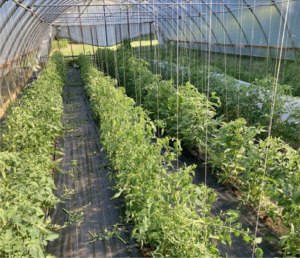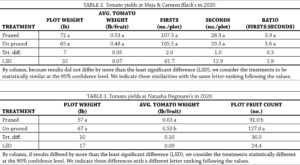This project was funded by Ceres Trust
In a Nutshell:
- Maja & Carmen Black and Natasha Hegmann were interested in learning the impact of double-leader pruning on tomato yield and labor-time in their high tunnels.
- Cooperators measured data on labor for different tasks along with tomato weight and fruit count.
Key Findings:
- The time spent on labor was higher for the pruned tomatoes at the Blacks, while at Hegmann’s, time spent on labor was higher for un-pruned tomatoes.
- At the Blacks’ there was no difference in yield, while at Hegmann’s the pruned plants produced larger fruits and the un-pruned plants produced more fruits.
Background
Pruning is a common technique used by farmers because it allows the plant to divert its energy toward producing fruit instead of growing more foliage. Benefits include the plant producing larger fruit earlier in the season along with less pest and disease issues.
The objective of this project was to evaluate the impact of double-leader pruning on tomato yield and labor-time in the high tunnel. The growers hypothesized that overall yield will be lower from pruned plants, but pruning would save enough labor during harvest to offset the loss.
Methods
Design
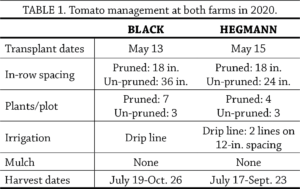 A randomized replicated trial of pruned vs. un-pruned tomatoes was conducted in the high tunnels of Maja & Carmen Black in Solon and Natasha Hegmann in Elkport (Figure A1). The variety used was Big Beef. The study had four replications of both treatments for a total of eight plots. The treatments were:
A randomized replicated trial of pruned vs. un-pruned tomatoes was conducted in the high tunnels of Maja & Carmen Black in Solon and Natasha Hegmann in Elkport (Figure A1). The variety used was Big Beef. The study had four replications of both treatments for a total of eight plots. The treatments were:
- Pruned- Tomatoes were pruned to double-leader and plants were string-trellised.
- Un-Pruned- Tomatoes were not pruned and plants were string-trellised.
Tomato management used for both growers is presented in Table 1.
Measurements
Maja & Carmen Black recorded fruit count (firsts and seconds) by plot and the plot weight of the harvested tomatoes. Natasha Hegmann collected the plot weight and the fruit count for each of the plots. Both farms logged the amount of labor associated with management activities of all plots for both the pruned and un-pruned tomatoes.
Data analysis
To evaluate any effects of pruning vs. not pruning on tomato yield, the least significant difference (LSD) was calculated using a t-test. If the difference in value was greater than or equal to the LSD, the treatment has a statistically significant effect. However, if the difference between the values was less than the LSD the treatments were considered to not have a significant effect on the values. For the Blacks’ measurements, we used a 95% confidence level for the calculations meaning we would expect our findings to occur 95 times out of 100. For Hegmann’s calculations, we used a 90% confidence level. These statistical calculations could be run because the growers experimental design included replication and randomization of the treatments (Figure A1). We did not conduct statistical analysis on labor.
Results and Discussion
Labor
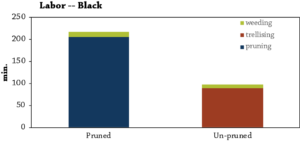
FIGURE 1. Time spent on labor at the Blacks’ farm divided by the task: weeding, trellising and pruning.
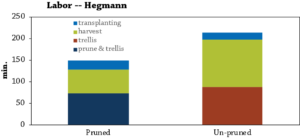
FIGURE 2. Time spent on labor at Hegmann’s farm divided by task: transplanting, harvesting and pruning & trellising for the pruned tomatoes; transplanting, harvesting and trellising for un-pruned tomatoes.
The Blacks recorded the amount of time spent on pruning, trellising and weeding. The total amount of labor was much higher for the pruned tomatoes at 216.5 minutes compared to the un-pruned tomatoes at 97 minutes (Figure 1). At Hegmann’s the labor breakdown was flipped. The un-pruned tomatoes took much longer to manage (by 66 minutes) than the pruned tomatoes (Figure 2). The disparity between farms most likely occurred because the Blacks recorded the amount of time it took to weed, trellis and prune while Hegmann recorded time spent transplanting, trellising, pruning and harvesting.
Yield
At the Blacks’, there was no difference in tomato yield for any of the measurements collected: plot weight, average tomato weight, number of firsts, number of seconds and the ratio of firsts to seconds (Table 2). At Hegmann’s, the pruned treatments produced larger fruits and the un-pruned treatments produced more fruits. Total plot weight, however, did not differ at Hegmanns (Table 3).
Conclusions and Next Steps
Maja & Carmen Black realized throughout this project how much they prefer harvesting pruned tomatoes compared to un-pruned tomatoes. The Blacks said, “It was very obvious to us that morale was higher for the pruned tomatoes compared to un-pruned tomatoes during harvest.” Moving forward the Blacks plan to continue to prune tomatoes as it is much more enjoyable work and there was no difference in yield compared to the un-pruned tomatoes. Likewise, Hegmann also plans to stick with pruning her tomato plants in the future because managing the un-pruned plots was much more stressful and burdensome.
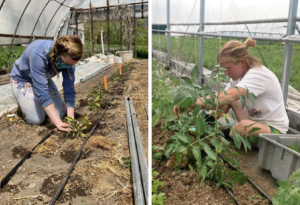
Left: Transplanting at Hegmann’s high tunnel. Right: Pruning at the Blacks’ high tunnel. Photo taken on June 10, 2020.
Appendix – Trial Design and Weather Conditions

FIGURE A1. Cooperators’ experimental design consisted of two treatments that had four repetitions to compare the effect of double-leader pruning on labor and yield of the tomatoes. This allowed statistical analysis of the results.

FIGURE A2. The monthly average temperature for the months May through October. The bars are the monthly average for 2020 while the lines are the monthly average from the years 1971 -2020. The data was accessed from the Cedar Rapids (Black) and Elkport (Hegmann) weather stations.[1]
References
-
Iowa Environmental Mesonet. 2021. Climodat Reports. Iowa State University. https://mesonet.agron.iastate.edu/ (accessed January 2021).


